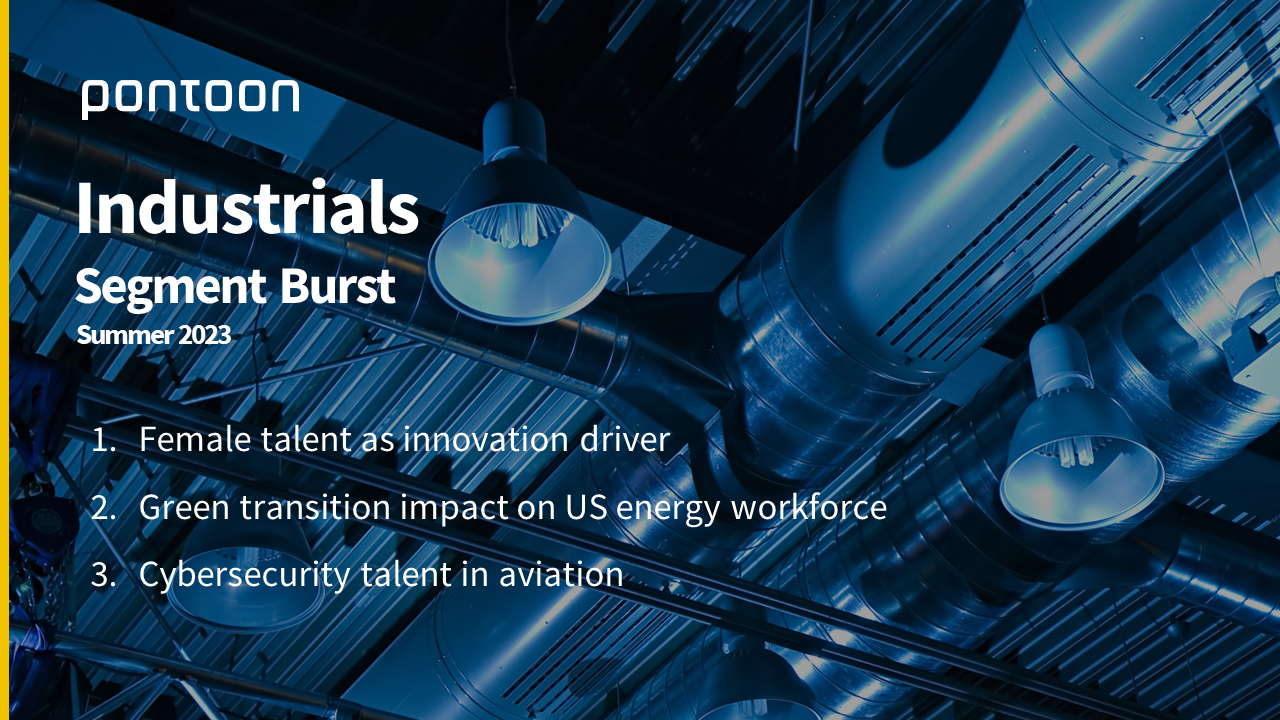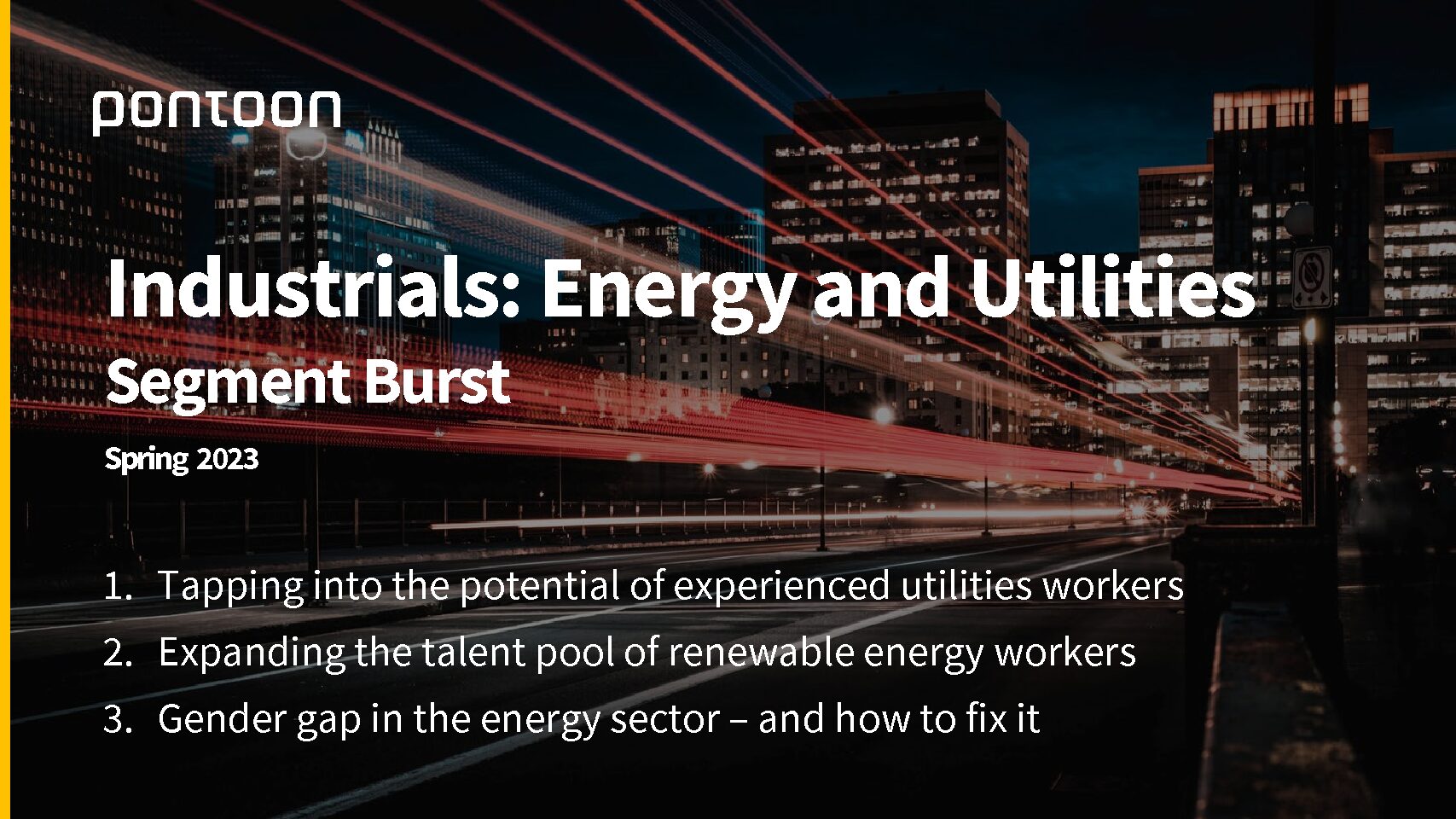Industrials Segment Burst: Summer 2023
Research
.
In the Summer 2023 volume of Industrials Segment Burst, we explore the most recent trends in the automotive, aviation, and green energy industries.
Female talent as innovation driver
It’s essential for automotive companies to attract more women into the industry by working closely with educational institutions. This collaborative approach to igniting female students’ interest in STEM will contribute to increased diversity in the field. Missing out on this opportunity is detrimental to both product development and sales.
Evidence suggests that bringing more women into the industry is beneficial for business, also on the CEO level. Research by the Harvard Business Review found that companies with more women in top leadership positions prioritise social responsibility and sustainability initiatives. They also drive company-wide changes that can improve risk management and financial performance. With more women in C-suite roles, a company’s propensity for risk-taking decreases by 14% while openness to change increases by 10%.
Additionally, female executives tend to shift away from M&A (mergers and acquisitions) strategies based on knowledge-buying to knowledge-building strategies. This significantly boosts innovation through internal R&D and increases collaboration within the business.
The need for female talent in the EV sector
Having female leaders, researchers, designers, and engineers on staff allows companies to more accurately understand and respond to their female consumer base. Women tend to make very rational buying choices based on car safety and performance. Concerns for safety are understandable given that until very recently safety engineers were basing their tests on crash test dummies modelled on an average male body. As a result, female drivers and passengers were 47% more likely than men to be seriously injured during a crash.
While these issues are now evident, a lot remains to be done about safety concerns in relation to the development of proper EV infrastructure. Even though 47% of women consumers would be interested in buying an electric car, it’s mostly men who dominate the EV market. The main reason might be related to safety concerns at public charging stations. Remote locations with no employees and a relatively long charging time might expose female drivers to assault and other threats to their life and health – and the same could be added for LGBTQ+ persons.
Without bringing in more talent from underrepresented groups, automotive companies are not setting themselves up for the success they could achieve otherwise.
Green transition impact on US energy workforce
Renewable energy sources are not only environmentally friendly, but they can also be more cost-effective.
Research suggests that almost all (99%) of coal plants in the US are more expensive to run than setting up renewable energy plants. Turning to local renewables is a cheaper solution for 97% of coal plants. Local ventures can not only save customers’ money but also drive over $589 billion of investment in energy communities across the country.
By 2030 and under the Inflation Reduction Act, each state in the US can add between 2,000 to 140,000 clean energy jobs. Many of these new positions will most likely be based in Oklahoma, Texas, and Florida due to their natural potential for sun- and wind-powered energy. Industrial states like Michigan, Ohio, and Pennsylvania will also see growth in clean energy manufacturing jobs. New jobs will include mechanics, electricians, construction workers, and technicians.
According to reports on new clean energy initiatives across 31 states, relevant talent will most likely be sourced from seven states: Texas, Ohio, Michigan, Georgia, Arizona, South Carolina, and Tennessee.
The importance of just transition for local talent communities
With the shift away from fossil fuels and towards renewable energy sources, it is important to remember the impact that the green transition has on coal workers. Several states passed just transition bills to aid local communities. For instance, Illinois mandated that renewable energy developers hire at least 10% of the displaced coal workers and underserved communities. The state has also launched a training programme, investing $80-million-a-year into clean-energy hubs that educate displaced workers.
Energy companies should help to drive that cultural and educational shift if they want to future-proof their business. Reskilling their current talent and leveraging laid-off workers from the competition as well as other industries might be an effective long-term strategy. However, to prepare for a changing talent market reality, companies need to act today.
Revisit our previous Segment Burst to learn more about strategies for widening the green energy talent pool.
Cybersecurity talent in aviation
Cybersecurity is an ongoing threat to aviation. In 2022, the industry faced 38 cybersecurity attacks, including 14 in the US, three in Italy, and two in Canada. A report by Eurocontrol (based on 2020 data) estimates that 61% of all aviation cyber-attacks are targeted at airlines and are aimed at financial gain through fraudulent websites. Fake airline websites are the second most commonly reported cyber-attack after data theft.
Manufacturers in the aviation industry experience only 16% of all cybercriminal activity but these attacks tend to have a higher negative impact. 75% of such events are classified by manufacturers as having medium or high impact compared to only 20% for airline security breaches. Threats pertinent to aviation manufacturing include data and intellectual property theft, ransomware, and attacks on supply chain and production, which all can have detrimental financial effects on the company.
While the number of cybersecurity professionals around the globe has grown to 4.7 million, 3.4 million more are still needed to satisfy the market demand. The United States alone needs to hire 700,000 cybersecurity specialists across all industries.
To keep up with the demand and prevent talent shortages, aviation leaders should consider investing in non-traditional applicants (including neurodiverse talent), female tech talent, and applicants sourced from outside overinflated tech markets. Offering upskilling initiatives is a good way of leveraging talented workers who want to make a career switch into aviation cybersecurity.
Related Post
In the Spring 2023 volume of Industrials Segment Burst, we explore the most recent trends in the energy and utilities industry.
Tapping into the potential of experienced utilities workers
With nearly one-third ...





